Introduction to Japanese Mythology
When we talk about the Japanese gods and goddesses, we must understand that much of the mythology and pantheon is derived from the traditional folklore of Shinto – one of the major religions of Japan. And interestingly enough, much like Hinduism, Shinto, or kami-no-michi (‘the Way of the Gods’) is a polytheistic mode of religion that results from the highly pluralistic culture of Japan throughout history.
In essence, Shinto, without any proclaimed founder or prescribed tenets, can be perceived as the evolution of local animalistic beliefs of Yayoi culture (300 BC – 300 AD) that were further influenced by both Buddhism and even Hinduism throughout the course of centuries.
And given the nature of these localized folklores (intermixed with the myths of venerated entities of Buddhism and Hinduism), the Japanese gods and goddesses are deities mostly based on the kami – the mythical spirits and supernatural beings of the land. In terms of history, the first of these mythologies were documented in written forms by the early 8th century – thus serving as a standardized (or at least generalized) template of the Shinto pantheon for most of Japan.
To that end, most of the mythical narratives of the Japanese gods and goddesses are derived from the codified books Kojiki (circa 708-714 AD), Nihon Shoki (circa 720 AD), and the 9th-century Kogoshui (that compiled the oral folklores that were missing from the earlier two codified documents).
Contents
- Introduction to Japanese Mythology
- Izanami and Izanagi – The Primordial Japanese Gods of Creation
- Yebisu – The Japanese God of Luck and Fishermen
- Kagutsuchi – The Japanese God of Destructive Fire
- Amaterasu – The Japanese Goddess of the Rising Sun
- Tsukiyomi – The Japanese God of the Moon
- Susanoo – The Japanese God of Seas and Storms
- Raijin and Fūjin – The Japanese Gods of Weather
- Ame-no-Uzume – The Japanese Goddess of Dawn and Dancing
- Hachiman – The Japanese God of War and Archery
- Inari – The Japanese Deity of Agriculture (Rice), Commerce, and Swords
- Kannon – The Japanese Deity of Mercy and Compassion
- Jizo – The Japanese Guardian God of Travellers and Children
Izanami and Izanagi – The Primordial Japanese Gods of Creation
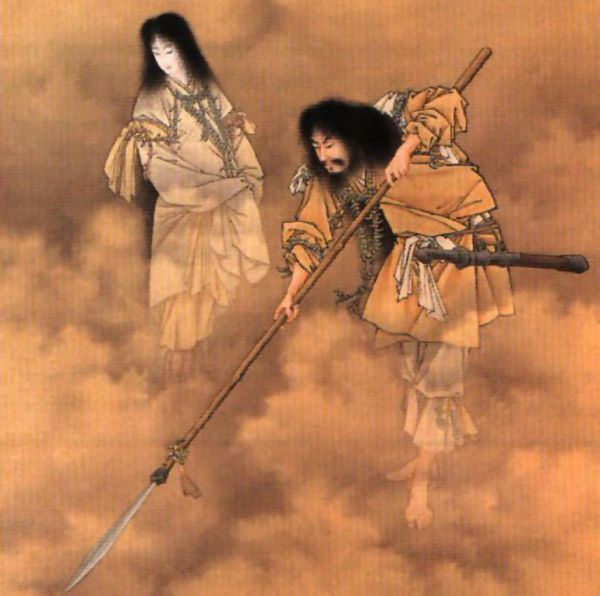
Like most creation myths, the Shinto-Japanese myth also consists of the primordial gods. Called Izanagi (Izanagi no Mikoto or ‘he who invites’) and Izanami (Izanami no Mikoto or ‘she who invites’), the duo of brother and sister are perceived as the divine beings who brought order to the sea of chaos below heaven by creating the first landmass – in the form of the island of Onogoro. Interestingly enough, most narratives concur that they were directed to do so by an even earlier generation of kami (divine beings) who resided in the plain of heaven.
Even more intriguing is the way the duo created the landmass, by standing on the bridge or stairway to heaven (Ama-no-hashidate) and stirring the chaotic ocean below with their jewel-encrusted spear, thereby giving rise to the island of Onogoro. However, in spite of their apparent ingenuity, things soon fell out of favor, with their first union creating a deformed offspring – the god Hiruko (or Ebisu – discussed later in the article).
Izanagi and Izanami went on to create more landmasses and give birth to other divine entities, thereby giving form to the principal eight islands of Japan and over 800 kami. Unfortunately, in the arduous process of creation, Izanami died from the burning pain of giving birth to Kagutsuchi – the Japanese fire god; and is consequently sent to the underworld (Yomi).
The grief-stricken Izanagi followed his sister Izanami to the underworld, and he even succeeded in convincing the older generation of gods to allow her to return to the realm of the living. But the brother, impatient from waiting too long, takes a premature look at the ‘undead’ state of the sister, which was more akin to a rotting, decomposing corpse. A host of angry thunder kami attached to this body chased Izanagi out of the underworld, and he just about escaped from Yomi by blocking the entrance with a huge stone.
A cleansing ritual followed, whereby Izanagi inadvertently created even more Japanese gods and goddesses – the Mihashira-no-uzunomiko, like Amaterasu – the sun goddess birthed from the washing of his left eye; Tsuki-yomi – the moon god birthed from the washing of his right eye, and Susanoo – the storm god birthed from his nose. To that end, in Shinto culture, cleansing (harai) is an important part of the ritual before entering the sacred shrines.
Yebisu – The Japanese God of Luck and Fishermen
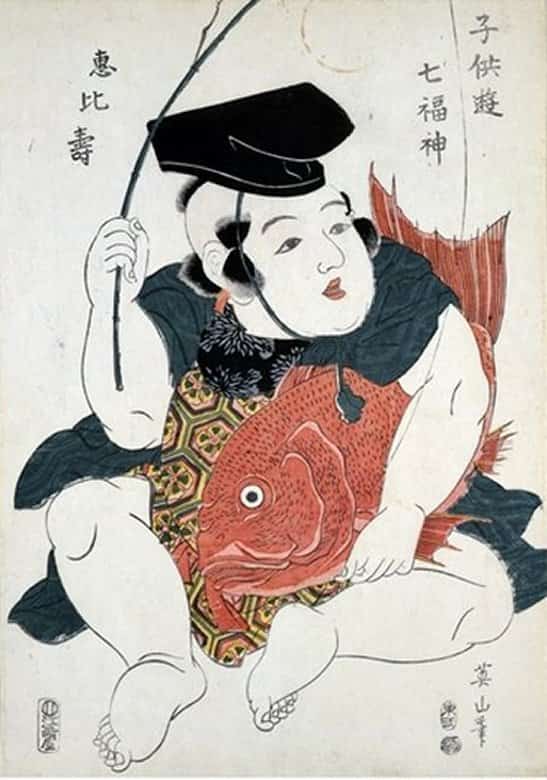
As we mentioned in the earlier entry, Hiruko (‘Leach Child’), the very first child of the primordial duo Izanagi and Izanami, was born in a deformed state – which, according to the mythical narrative, was due to a transgression in their marriage ritual. However, in some narratives, Hiruko was later identified with the Japanese god Yebisu (possibly in medieval times), a deity of fishermen and luck. In that regard, the myth of Yebisu was possibly modified to accommodate his divine (and rather indigenous) lineage amongst the Japanese kami.
In essence, Yebisu (or Hiruko), after being born without bones, was said to have been set adrift in the ocean at age three. In spite of this immoral trial, the child, by luck, somehow managed to come ashore to one Ebisu Saburo. The child then grew through various hardships to call himself Ebisu or Yebisu, thereby becoming the patron god of fishermen, children, and most importantly wealth and fortune.
Pertaining to the latter attribute, Yebisu is often considered one of the primary deities of the Seven Gods of Fortune (Shichifukujin), whose narrative is influenced by local folklore as opposed to foreign influence. As for depictions, in spite of his numerous adversities, Yebisu maintains his jovial mood (often called the ‘laughing god’) and wears a tall, pointed cap folded in the middle called kazaori eboshi. On an interesting note, Yebisu is also the god of jellyfish, given his initial boneless form.
Kagutsuchi – The Japanese God of Destructive Fire
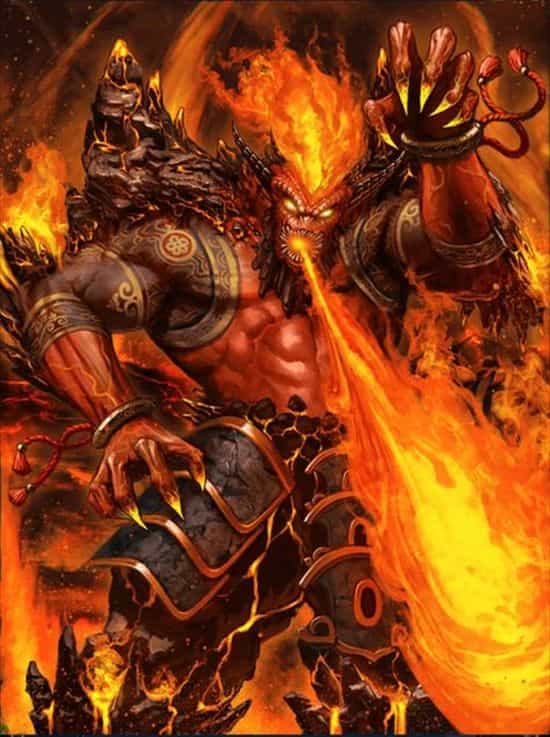
The Japanese god of fire, Kagutsuchi (or Homusubi – ‘he who starts fire’) was another offspring of the primordial Izanagi and Izanami. In a tragic twist of fate, his fiery essence burned his own mother Izanami, which led to her death and departure to the underworld. In a fit of rage and revenge, his father Izanagi proceeded to lop off Kagutsuchi’s head – and the spilled blood led to the creation of even more kami, including martial thunder gods, mountain gods, and even a dragon god.
Simply put, Kagutsuchi was regarded as the forebearer of various potent and powerful deities who even brought forth the creation of iron and weapons in Japan (possibly mirroring the foreign influence in different armaments of Japan).
As for the history and cultural side of affairs, Kagutsuchi, as a god of fire, was unsurprisingly perceived as a (potential) agent of destruction to Japanese buildings and structures typically made of wood and other combustible materials. Suffice it to say, in Shinto religion, he becomes the focus of different appeasing rituals – with one ceremony pertaining to the Ho-shizume-no-matsuri, an imperial custom that was designed to ward off the destructive effects of Kagutsuchi for six months.
Amaterasu – The Japanese Goddess of the Rising Sun
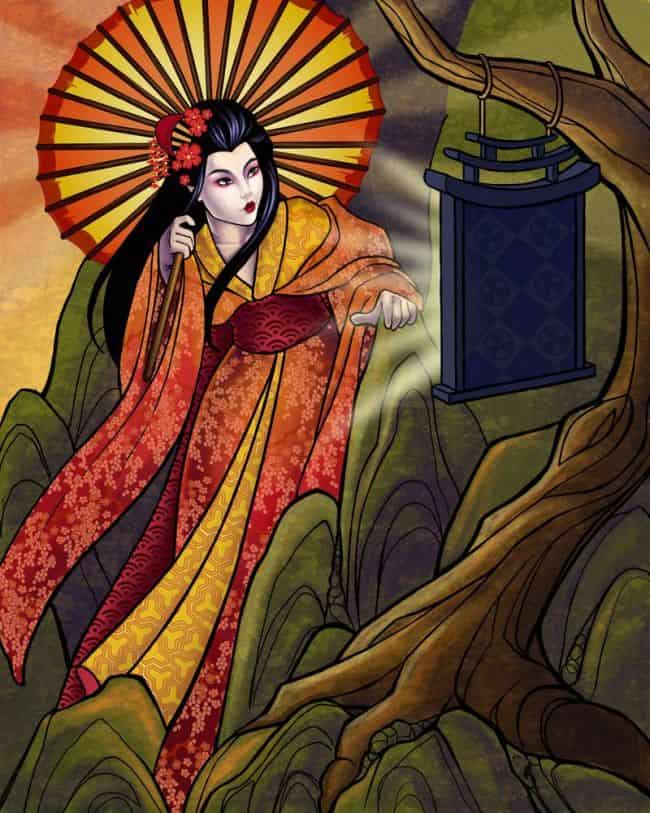
Amaterasu or Amaterasu Omikami (‘the glorious kami who illuminates from heaven’), also known by her honorific title Ōhirume-no-muchi-no-kami (‘the great sun of the kami’), is venerated as the goddess of the sun and the ruler of the realm of the kami – the High Celestial Plain or Takama no Hara.
In many ways, as Queen of the kami, she espouses the grandeur, order, and purity of the rising sun, while also being the mythical ancestor of the Japanese Imperial family (thus alluding to their mythical lineage in the Japanese culture). Her epithet suggests her role as the leader of the gods, with the rulership directly granted by her father Izanagi – the creator of many Japanese gods and goddesses.
In that regard, one of the crucial Shinto myths talks about how Amaterasu herself, as one of the Mihashira-no-uzunomiko, was birthed from the cleansing of Izanagi’s left eye (as mentioned in our first entry). Another popular myth pertains to how Amaterasu locked herself in a cave after having a violent altercation with Susanoo, the storm god.
Unfortunately, for the world, her radiant aura (epitomizing the effulgent sun) was hidden, thus covering the lands in darkness. And it was only after a series of friendly distractions and pranks concocted by the other Japanese gods that she was convinced to come out of the cave – which once again resulted in the advent of radiant sunlight.
As for the lineage in cultural terms, the Japanese Imperial line is mythically derived from the grandson of Amaterasu – Ninigi-no-Mikoto, who was offered the rulership of Earth by his grandmother. On the historical side of affairs, Amaterasu (or her equivalent deity) had always been important in the Japanese lands, with many noble families claiming lineage from the sun deity. But her prominence was rather enhanced after the Meiji Restoration, in accordance with tenets of the Shinto state religion.
Tsukiyomi – The Japanese God of the Moon
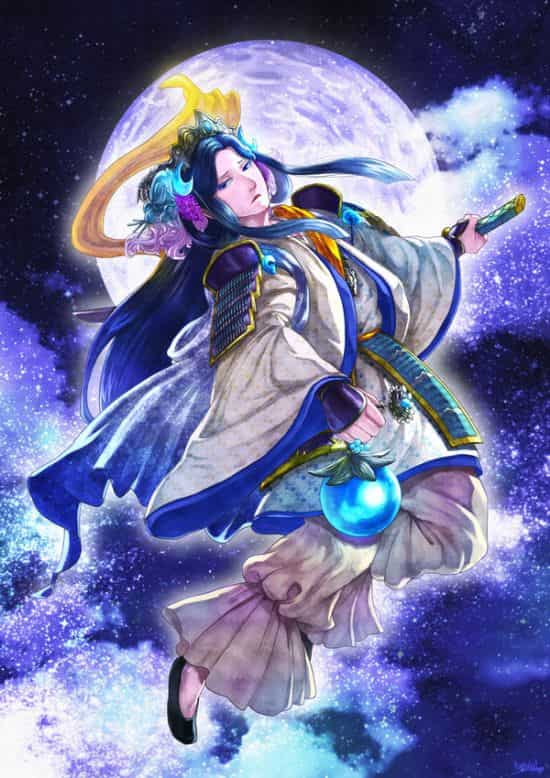
In contrast to many Western mythologies, the Moon deity in Japanese Shinto is a male – given the epithet of Tsukiyomi no Mikoto or simply Tsukiyomi (tsuku probably meaning ‘moon, month’ and yomi referring to ‘reading’). He is one of the Mihashira-no-uzunomiko, being born from the washing of Izanagi’s right eye – therefore making him the brother of Amaterasu, the sun goddess. In some myths, he is born from a white copper mirror held in the right hand of Izanagi.
As for the mythical narrative, Tsukiyomi, the god of the moon went on to marry his sister Amaterasu, the goddess of the sun, thereby allowing for the union of both the sun and the moon in the same sky. However, the relationship was soon shattered when Tsukiyomi killed Uke Mochi, the goddess of food.
The heinous act was apparently carried out of disgust when the moon god was witness to Uke Mochi’s spitting out of various food items. In response, Amaterasu broke off with Tsukiyomi by moving to another part of the sky, thus making day and night completely separate.
Susanoo – The Japanese God of Seas and Storms
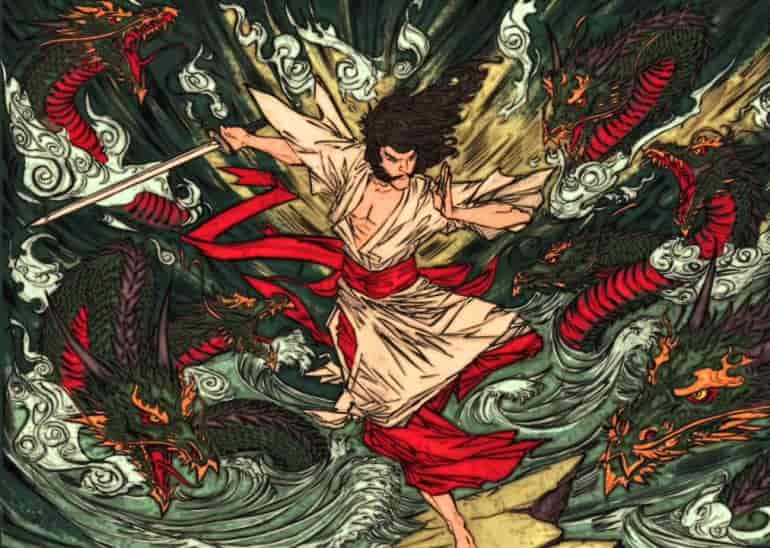
Born from the nose of Izanagi, the father of Japanese gods, Susanoo was a member of the trio of Mihashira-no-uzunomiko, thereby making him a brother to both Amaterasu and Tsukiyomi. As for his attributes, Susanoo was perceived as a temperamental, disheveled kami who is prone to chaotic mood swings – thus alluding to his power over the everchanging storms. Mythically, the mercurial nature of his benevolence (and malevolence) also extends to the seas and winds near the coast – where many of his shrines are located in South Japan.
Talking of myths, Susanoo is often celebrated in Shinto folklore as the guileful champion who defeated the evil dragon (or monstrous serpent) Yamata-no-Orochi by cutting off all its ten heads after imbibing them with alcohol. After the encounter, he recovered the famed sword Kusanagi-no-Tsurugi and also won the hand of the woman he saved from the dragon.
On the other hand, Susanoo is also portrayed in a somewhat negative light (thus reflecting the storm god’s chaotic nature), especially when it comes to his rivalry with Amaterasu, the leader and sun goddess of the kami.
On one occasion, their challenge to each other turned bitter, with the wrathful Susanoo going on a rampage by destroying the sun goddess’s rice fields and even killing one of her attendants. In response, the angry Amaterasu retreated into a dark cave, thus snatching away her divine light from the world, while the ever-boisterous Susanoo went away from heaven.
Raijin and Fūjin – The Japanese Gods of Weather
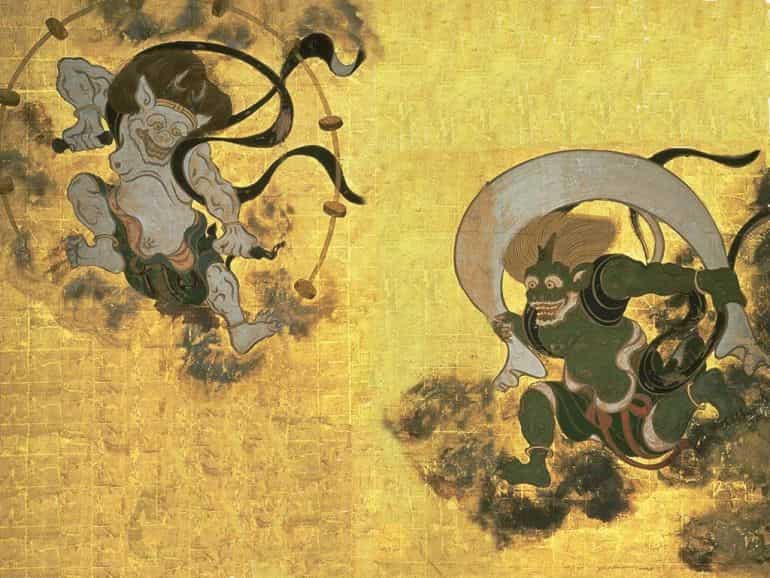
Talking of storms and duality of character, Raijin and Fujin are considered the powerful kami of the elements of nature who can be favoring or disagreeable to the plights of mortals. To that end, Raijin is the deity of thunder and lightning who unleashes his tempests by wielding his hammer and beating drums. Interestingly enough, Raijin is depicted with three fingers – each representing the past, present, and future.
Fujin, on the other hand, is the fearsome monstrous kami of the winds, who carries his fair share of gales and gusts in a bag on his shoulders. According to a few myths, it was Fujin who saved Japan during the Mongol invasions by unleashing a typhoon on the approaching fleet – which was later called the kamikaze (‘divine wind’).
However, other Samurai-related myths call it the work of Hachiman – the god of war (discussed later in the article). Interestingly enough, there is a hypothesis regarding how Fujin was possibly inspired by the Greco-Buddhist deity Wardo (venerated along the Silk Route), who, in turn, was derived from the Greek wind god Boreas.
Ame-no-Uzume – The Japanese Goddess of Dawn and Dancing
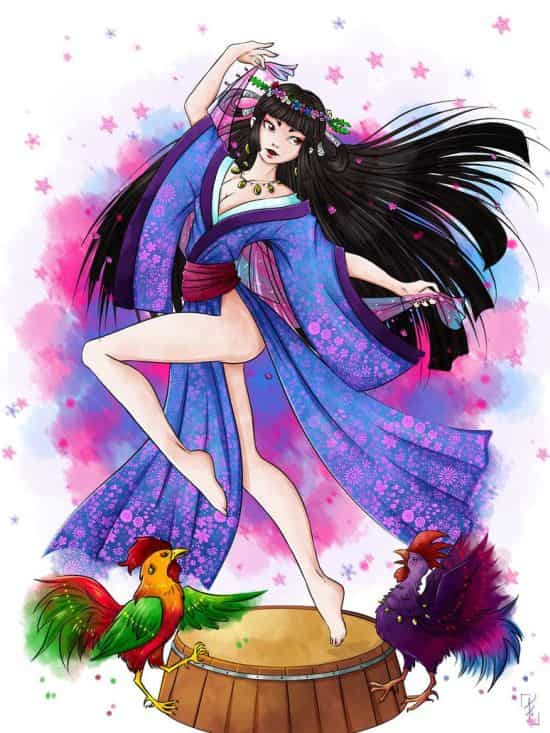
The jovial female deity of the dawn (which sort of made her the assistant to Amaterasu, the deity of the sun), Ame-no-Uzume also espoused the spontaneity of nature. This latter aspect made her the patron goddess of creativity and performing arts, including dancing.
To that end, one of the central myths in Shinto pertains to how Amaterasu, the sun goddess, locked herself in a dark cave after falling out with Susanoo, the storm god. This resulted in the arrival of darkness over the heavens and the earth.
So, in a bid to distract the other anxious kami, Ame-no-Uzume, by virtue of her intrinsic spontaneity and creativity, covered herself in the leaves of the Sakaki tree. She then started making cheery cries and it was followed up by gleeful dancing atop a platform.
She even resorted to removing her clothes, which led to amusement among the other gods who started roaring in joy and laughter. The ensuing merriment steered the curiosity of Amaterasu, who finally came out of her cave, and thus the world was once again covered in radiant sunlight.
Hachiman – The Japanese God of War and Archery
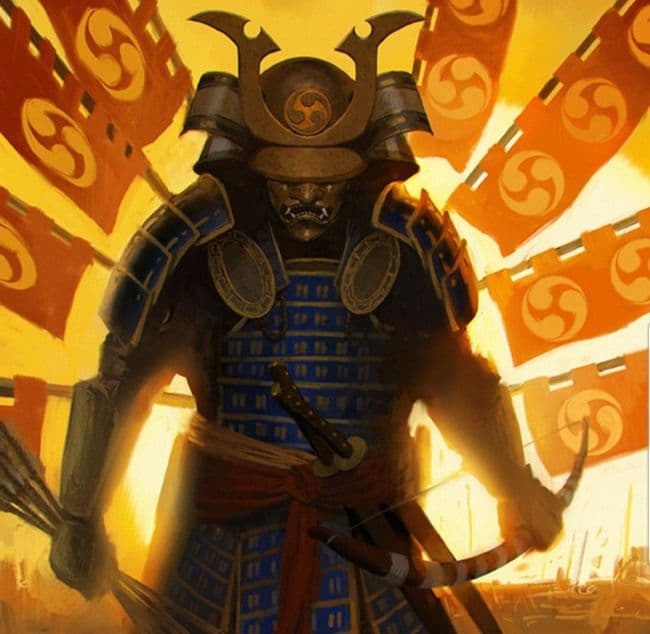
Hachiman (also called Yahata no kami) epitomizes the syncretism between Shinto and Buddhism in early medieval Japan. Revered as the god of war, archery, culture, and even divination, the deity possibly evolved (or had grown in importance) with the establishment of various Buddhist shrines in the country after circa 9th century AD. To that end, in a classic example of cultural overlap, Hachiman, the kami of war, is also venerated as a bodhisattva (Japanese Buddhist deity) who acts as the steadfast guardian to numerous shrines in Japan.
As for his intrinsic association with war and culture, Hachiman was said to have his avatars carry forth the legacy and influence of the burgeoning Japanese society. In that regard, mythically, one of his avatars resided in Empress Jingu who invaded Korea, while another was reborn as her son Emperor Ojin (circa late 3rd century AD) who brought back Chinese and Korean scholars to his court.
Hachiman was also touted as the patron deity of the influential Minamoto clan (circa 11th century AD), which rather advanced their political cause and claimed lineage to the semi-legendary Ojin. As for one of the popular myths, it was Hachiman who saved Japan during the Mongol invasions by unleashing a typhoon on the approaching fleet – which was later called the kamikaze (‘divine wind’).
Inari – The Japanese Deity of Agriculture (Rice), Commerce, and Swords
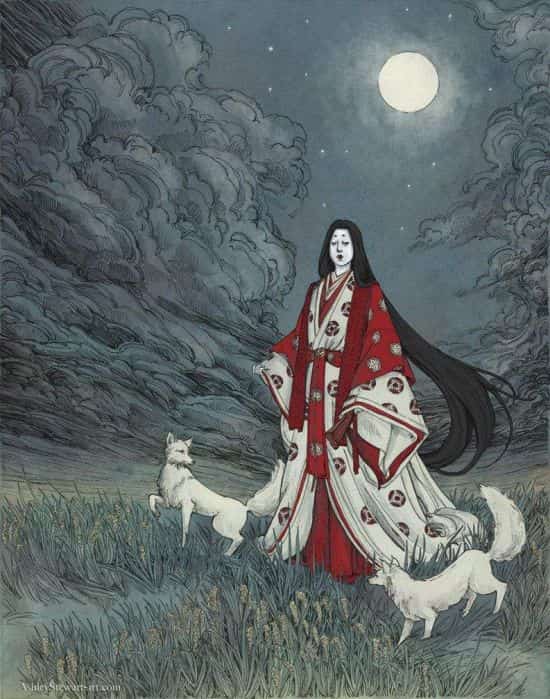
Considered one of the most revered kami in the Shinto pantheon, Inari, often depicted in dual-gender (sometimes male and sometimes female), is the god of rice (or rice field), thereby alluding to the association with prosperity, agriculture, and abundance of produce.
Pertaining to the former, Inari was also revered as the patron deity of merchants, tradesmen, entertainers, and even swordsmiths. In some mythical narratives, he/she is perceived as the progeny of Susanoo – the storm god.
Interestingly enough, mirroring the deity’s vague gender (who was often depicted as an old man, while in other instances, was depicted as a woman with a head of a fox or accompanied by foxes), Inari was also identified with various other Japanese kami.
For example, in Shinto traditions, Inari was associated with benevolent spirits like Hettsui-no-kami (goddess of the kitchen) and Uke Mochi (goddess of food). On the other hand, in Buddhist traditions, Inari is venerated as the Chinjugami (protector of temples) and Dakiniten – who was derived from the Indian Hindu-Buddhist deity of dakini or celestial goddess.
Kannon – The Japanese Deity of Mercy and Compassion
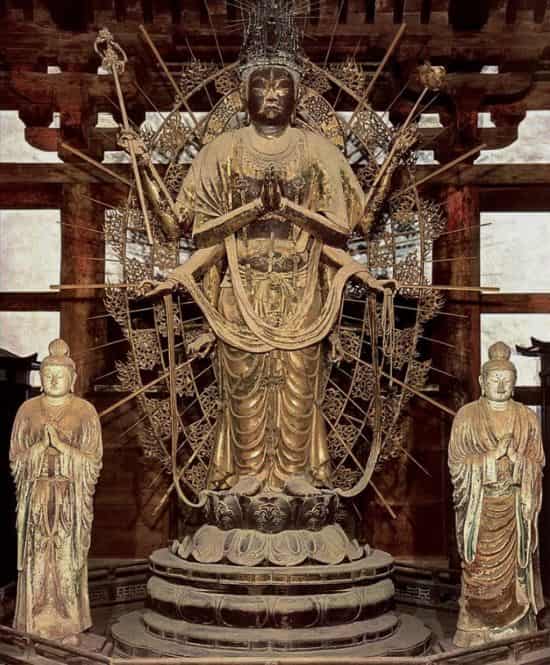
Talking of Buddhist traditions and their influence on the native pantheon, Kannon serves as one of the most important Buddhist deities of Japan. Venerated as the god of mercy, compassion, and even pets, the deity is revered as a Bodhisattva.
Interestingly enough, as opposed to direct transmission from China, the figure of Kannon is probably derived from Avalokitêśvara – an Indian deity, whose name in Sanskrit translates to the ‘Lord Who Regards All’. To that end, even Kannon’s paradise – Fudarakusen, is regarded by many Japanese adherents to be in the southern tip of India.
In the religious and mythical scheme of things, Kannon, like some other Japanese gods, have variations in the form of gender, thus expanding upon their aspects and associations. For example, in the feminine form of Koyasu Kannon, he/she represents the aspect of child-giving, while in the form of Jibo Kannon, he/she represents the loving mother.
Quite intriguingly, Kannon is also revered in Japan’s other religious denominations – in Shinto, he is the companion of Amaterasu, while in Christianity, he/she is venerated as Maria Kannon (the equivalent of the Virgin Mary).
Jizo – The Japanese Guardian God of Travellers and Children
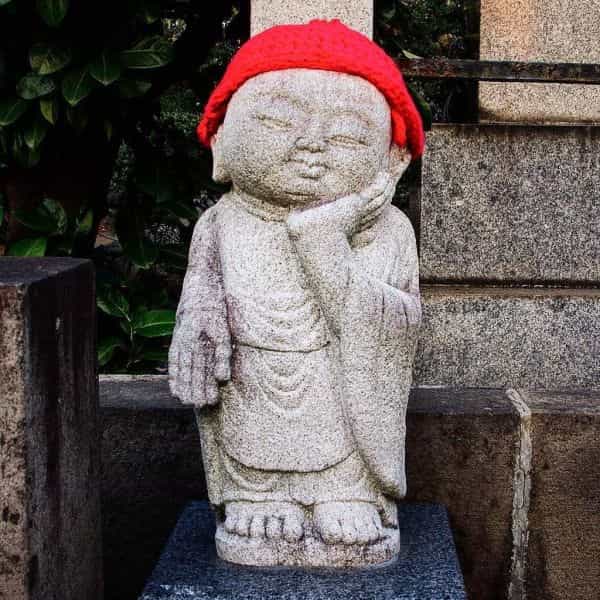
Another Bodhisattva among the Japanese gods, the ever-beloved Jizo is venerated as the protector of the children, the weak, and the travelers. Pertaining to the former, in the mythical narrative, Jizo had the profound duty of alleviating the suffering of the lost souls in hell and guiding them back to the western paradise of Amida (one of the principal Japanese Buddhist deities) – a plane where souls are freed from karmic rebirth.
In a poignant parcel of the Buddhist traditions, the unborn children (and small children who died before their parents) don’t have time on Earth to fulfill their karma, thus being confined to the purgatory of souls. Thus Jizo’s task becomes even more crucial; he aids these child souls by carrying them in the sleeves of his robes.
As for the cheerful countenance of Jizo, the good-natured Japanese god is often depicted as a simple monk who forgoes any form of ostentatious ornaments and regalia befitting an important Japanese god.
Featured Image Credit: Feig Felipe Pérez (ArtStation)
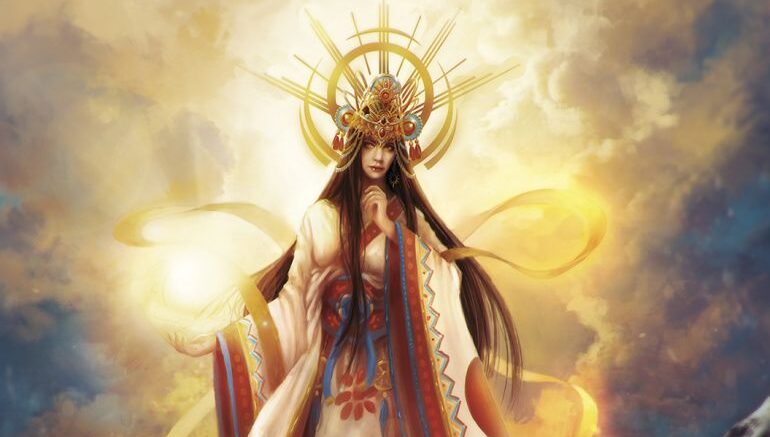
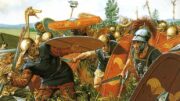
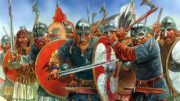

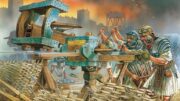
Hi, this is a comment.
To get started with moderating, editing, and deleting comments, please visit the Comments screen in the dashboard.
Commenter avatars come from Gravatar.